Like most large cities these days, London exists in three dimensions. The high-rise buildings climbing into the sky are obvious to everyone, but the vital arteries below the ground — the gas, electricity and water utilities and, perhaps most of all, the London Underground — receive comparatively little attention. But subterranean London has been jolted to the surface of public consciousness in recent weeks, as the most visible phase of the development of a new part of the sub-city swings into action: the excavation of the tunnels for Crossrail.
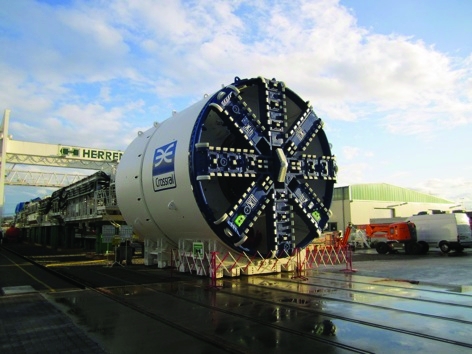
Mooted for decades but only just getting off — or rather under — the ground, Crossrail is the scheme to link the commuter areas to the East and West of the capital to major transport and business hubs — Heathrow Airport, Paddington, the City, Canary Wharf and Liverpool Street. In order to do this, the line dives underground through 21km of new tunnel, from Royal Oak in the West to Stratford in the Northeast and Plumstead in the Southeast, and along this route are seven new stations, at Paddington, Bond Street, Tottenham Court Road, Farringdon, Liverpool Street, Whitechapel and Canary Wharf.
For many Londoners, Crossrail has been a visible presence for some time, particularly with a large building works behind hoardings near Tottenham Court Road station, but the start of tunnel construction marks the beginning of perhaps the most challenging phase of the project. Tunnelling is always a technologically challenging task, but London’s underground city is the oldest and one of the most complex in the world; the oldest section of the Tube is 149 years old, with eleven lines running from just below the surface to a deepest point 67.4m underground, and with a whole range of cellars, basements, sewers, water mains and a variety of other structures. For Crossrail’s chief engineer, Chris Dulake, it’s the trickiest part of the project. ‘It’s quite a challenge to plan the alignment of the tunnel when you’re threading your way through all the tunnels and services,’ he told The Engineer; the closest approach that the Crossrail tunnel will make to an existing tunnel is less than a metre. The task is made even more difficult because the minimum turning radius of the tunnel boring machines (TBMs) that are excavating the tunnels have a minimum turning radius of 250m.
“It’s quite a challenge to plan the alignment of the tunnel when you’re threading your way through all the tunnels and services”Chris Dulake, chief engineer, Crossrail
The TBMs are imposing machines, as The Engineer can attest from a recent visit to the Royal Oak Portal where the first tunnel drive is to be launched. The front section is a towering cylinder 7.1m across, whose front surface is the rotating cutting head which will bite into the London Clay to dig the tunnel. The segment immediately behind the cutting head places the precast concrete segments of the tunnel walls into position, fixes them in place, and fills the space between the edge of the excavated tunnel and the outer edge of the lining section with cement grout, leaving behind a lined tunnel with a diameter of 6.4m.
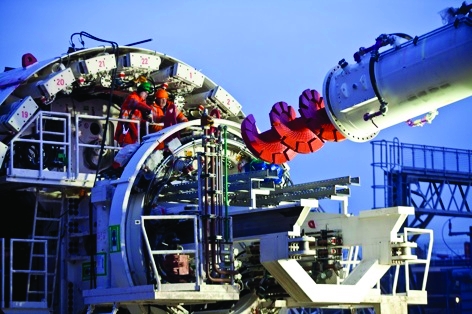
The excavated spoil falls into a space behind the cutting head, where the forward motion of the head pushes it into a screw conveyor which carries it through the back of the machine, to the top of the tunnel, where a long conveyor system takes it back to the portal site.
The machine advances via a series of hydraulic rams around the circumference of the rear end of the lining-placing unit, which push against the freshly-installed tunnel lining and creep the machine along at a rate of about 100m per week. They also provide the steering of the machine — varying the pressure of the rams on one side relative to the other can curve the path in any direction.
Behind the head of the TBM trails some 140m of machinery to bring the lining sections to the placing mechanism, carry the spoil away to conveyors at the top of the tunnel to take it back to the portal, and also housing facilities for the 20-strong crew of operators and miners who run the TBM, including toilets, a cafeteria and a safe flameproof refuge in case of emergencies, equipped with its own oxygen and supplies to remain self-sufficient for 24 hours.
Dulake, a tunnelling veteran, says there have been many innovations over the years in TBMs. ‘We’re now getting to a state of the art position with TBMs, with the provision of safety in particular developing considerably,’ he said. ‘We have systems for fire suppression and as far as possible the machinery is intrinsically safe. Each project informs the next — the specifications for the TBMs for the Jubilee Line extension formed the basis for the Channel Tunnel machines, and those formed the basis for the Crossrail machines. You’d have to question where the next innovation would come from — perhaps going to full automation or at least reducing the crew numbers.’
Dulake is also keen to tackle the question of why the TBMs were sourced from Germany rather than from a UK manufacturer, and the answer is simple. ‘We don’t have a UK manufacturer for TBMs,’ he said. ‘We used to dabble in it but you’d have to go a hell of a long way back to find someone who could deliver one from scratch.’ The issue, he explained, is that the UK doesn’t have a ready home market for TBMs - tunnelling projects here tend to have been planned on a rather piecemeal basis, and the countries which do manufacture them — notably Germany, Japan and the US — tend to have a lot more infrastructure which needs to be tunnelled out of rock. ‘But we do have a number of tunnelling projects in the UK coming up over the next few years,’ Dulake commented. ‘Perhaps that means there’s an opportunity for UK industry there.’
The tunnel lining are also no mean feat of engineering. The lining for the Western is being made on the site of an old Great Western Railway depot at Old Oak Common, handily close to the Royal Oak Portal, operated by Team BFK, the contractor for the western tunnel section of Crossrail, a joint venture between BAM Nuttall, Ferrovial Agroman and Kier Construction.
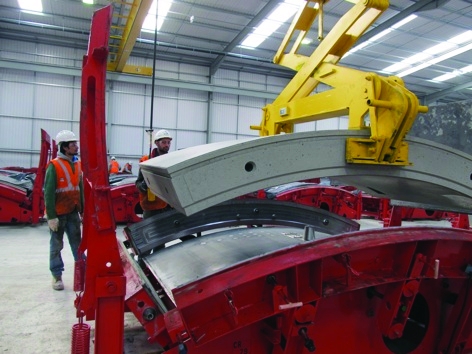
The concrete for the linings consists of cement and sand along with polypropylene fibres, which prevent the concrete breaking apart in the event of fire (a process called explosive spalling can take place, where water trapped in the concrete vapourises and shatters the concrete surface) and steel strips which add flexibility and strength, stitching the material together if it should start to crack. A similar mix was used in the Channel Tunnel linings, explained Bob Wagstaff, segment factory manager for Team BFK.
Each tunnel lining ‘ring’ consists of eight sections: seven curved segments and a keystone. For the main tunnel, the curved segments are each 1.6m or 1m wide; the wider segments each weigh around 3.5tonnes. The whole ring section curves very slightly, and ‘left’ and ‘right’ hand rings are being cast; on straight sections of the tunnel, left and right will alternate.
The casting hall is a surprisingly colourful place, as the steel moulds for the segments are colour-coded: red, green, blue, white and yellow moulds indicate segment size and direction of curve. The concrete is carried in from a large mixer outside the hall and piped into the moulds, which are fitted with a vibrating unit to make sure that air bubbles are forced out of the mixture as it pours. There are 213 moulds in total, and while the factory operates, it will produce around a quarter of a million tunnel lining sections; at full strength, said project controls manager Danny Trup, the facility will employ about 60 people, including 15 apprentices, and will produce 20 lining rings per day.
The Data
Tunnel Boring Machines
Crossrail will use eight TBMs, six of the Earth Pressure Balance type and two Slurry Machines, catering for different ground types. Slurry machines have an airlocked chamber behind the cutting head and use an outlet pipe rather than conveyor system
Diameter of tunnel 6.2m
Cutting head diameter 7.1m
Total length 148m
Weight 980tonnes
Head rotation up to 3.19rpm
Nominal thrust force 58,000kN
Precision of tunnelling route 1mm
Programmed steering and monitoring by GPS
The tunnel itself is only part of the story. The part of Crossrail which passengers will see most of is the stations, whose construction is also proceeding. These are being built in several different ways, Dulake explained. The four central stations — Bond Street, Tottenham Court Road, Liverpool Street and Whitechapel — are mined constructions; that is, they are excavated below the ground, rather than being dug from the surface down. But for the former two, the tunnel will be built first, then the tunnel linings removed in the station area and the platform tunnels mined out around them. For the eastern stations, the station tunnels will be dug and lined first, using spray-concrete to form the walls, then the TBMs will be driven into the prepared tunnel, dragged through it, and relaunched at the other end.
“Our ideal is that we build the line with nobody noticing”
The reason for this is to do with scheduling — the TBMs will reach Bond St and Tottenham Court Road before they reach Liverpool Street and Whitechapel — and to do with how the spoil is removed from the sites, Dulake said. ‘The principal advantage on the western side is that we’re trying to reduce the impact of the works on the surrounding area, and it means that we can take all the spoil out through the tunnel and back to Royal Oak, rather than loading it onto lorries and have to drive it out through central London every day, all the way through Oxford Street and the West End,’ he explained.
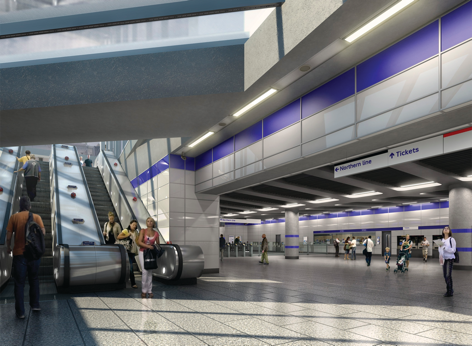
Reducing impact is a cardinal goal for Crossrail, he added. ‘Our ideal is that we build the line with nobody noticing,’ he said. ‘As we go underneath individual buildings, they might feel some vibration, but at a rate of 100m per week they’d only feel it for a day or two at most. Even though this is a huge project, the goal is for it to be invisible engineering.’
The station construction also illustrates the way the line has been designed to reduce the energy needed to operate the trains once it is complete, Dulake added. ‘Ideally, you need to have an uphill gradient on the way into stations, so you roll in and slow down, and a downhill gradient on the way out, so you accelerate as you pull away. That gives you the ability to regenerate power as you slow down, and that reduces the electricity bill for running the line by about 20 per cent. But it makes planning the route and alignment even more complicated, of course.’
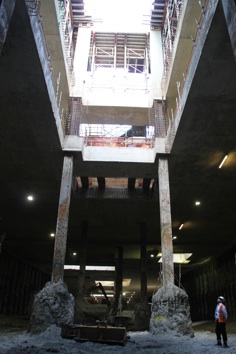
The scale of the stations is striking. It’s very easy to ignore the presence of the Underground when at street level — all a pedestrian sees are the station entrances with no indication of the spread, depth or orientation of the structures below ground. But to give a single example, the station ‘box’ of Canary Wharf is large enough for the whole of the largest Docklands skyscraper, 1 Canada Square, to be laid down inside it. Canary Wharf is the largest station on Crossrail, but sizes of the other stations are not far short.
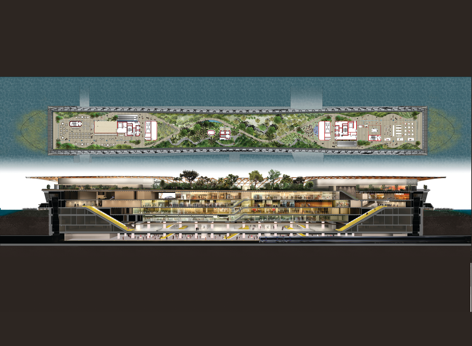
This, of course, impacts on the planning issue, and the need to avoid existing structures. Dulake keeps a book on the history of London’s underground landscape in his office, and the planning stages of Crossrail have taken into account all the surveys, works history and mapping of all the previous underground works underneath the capital. ‘We’ve got all the historical geotechnical papers for basements and other structures; we’ve done a great deal of ground investigation. I wouldn’t say we know everything, but we know a lot; we certainly know a lot more than previous projects.’ Nonetheless, he said, ‘there are always surprises. In the very unlikely event that we find something underground that we don’t know about, we have mitigation plans for managing that with our contractors.’
“We’ve done a great deal of ground investigation. I wouldn’t say we know everything, but we know a lot”
What sort of things might they find? The London Underground is one of the world’s most fertile breeding ground for urban myths and legends, from grisly tales of medieval plague pits to lost art treasures from the Second World War, long-forgotten munitions dumps and a possible buried tunnel boring machine at Tottenham Court Road (‘Not likely,’ Dulake said) and — our particular favourite — the eleven distinct subspecies of mosquito that are rumoured to have evolved along the route of each line. If you were to believe films , TV and books, there are buried malevolent aliens (Quatermass and the Pit), a whole parallel civilisation of noble houses and angels (Neverwhere) or the headquarters of the next phase of evolution of the human race (The Tomorrow People).
All complete fancy, of course. But Dulake is conscious of the place that Crossrail will occupy in London’s heritage. ‘This is the sort of thing that people tell stories about — tunnelling under London is part of a continuum that includes Marc Brunel and Joseph Bazalgette,’ he said. ‘It’s very exciting to be a part of it.’
Panel
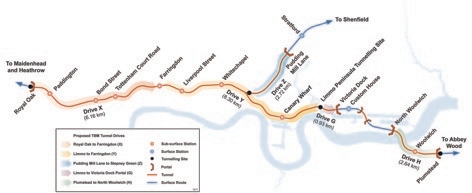
The Crossrail tunnels are being built in ten separate stages — known as drives —using eight TBMs. The longest drive, 8.3km, is from the Limmo Peninsula (on the opposite side of the Thames to the Millennium Dome) to Farringdon; the shortest just 0.93km from Limmo to the Victoria Docks. The first drive, from Royal Oak to Farringdon, will be complete in the third quarter of next year. The last tunnel drive — Limmo to Victoria — will take place in 2014, with all tunnelling scheduled for completion by the third quarter of that year.
Materials for tunnel construction, such as the lining segments and grouting cement, will be brought to the TBMs via a light railway, laid by the TBM as it progresses down the tunnel. Spoil is removed via a conveyor belt running along the tunnel roof.
Once conveyed back to the tunnel portals, the spoil will be loaded onto special trains and sent to Northfleet, on the southern side of the Thames estuary, where it will be loaded onto barges and sent to Wallasea Island in Essex, where it will be used in a completely different type of civil engineering project— a project to create a nature reserve by recreating the ancient wetland landscape of mudflat, saltmarsh, lagoon and pasture.
But the tunnels are only a part of the project, challenging though they are. Station construction, line laying, signalling, and fitting out, as well as linking the new line into the existing rail route to complete the whole 37-station cross-London link from Maidenhead in the west to Shenfield in the east, is equally dauting and will take another four years.
The whole line is set to cost £14.8billion — a budget set in 2010 – with funding coming from diverse sources including BAA, the City of London Corporation and Berkeley Homes as well as from central government and the Mayor of London. When complete, in 2018, the maximum journey time from Shenfield to Maidenhead will be 91min, with the tunnel section from Stratford to Paddington taking 18min.




Red Bull makes hydrogen fuel cell play with AVL
Formula 1 is an anachronistic anomaly where its only cutting edge is in engine development. The rules prohibit any real innovation and there would be...